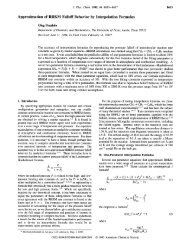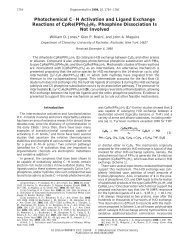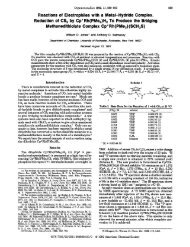Organometallics 2010, 29, 2430â2445 - Chemistry - University of ...
Organometallics 2010, 29, 2430â2445 - Chemistry - University of ...
Organometallics 2010, 29, 2430â2445 - Chemistry - University of ...
You also want an ePaper? Increase the reach of your titles
YUMPU automatically turns print PDFs into web optimized ePapers that Google loves.
Article <strong>Organometallics</strong>, Vol. <strong>29</strong>, No. 11, <strong>2010</strong> 2433<br />
protons. When the temperature was raised to -30 °C, the<br />
resonances <strong>of</strong> the η 2 -arene complexes disappeared (see Supporting<br />
Information, Figure SI-2). Upon heating, a new<br />
complex appeared in the 31 P{ 1 H} NMR spectrum (δ 70.8<br />
and 82.5, J P-P = 26 Hz), corresponding to the C-CN<br />
cleavage product B5. After heating at 60 °C for 13 h,<br />
B1-B4 completely converted to B5. A single-crystal structure<br />
<strong>of</strong> B5 was obtained and is shown in Figure 4.<br />
Figure 4. ORTEP drawing <strong>of</strong> (dippe)Ni(3-cyanophenyl)(CN)<br />
(B5). Ellipsoids are shown at the 50% probability level. Selected<br />
bond lengths (A˚ ): Ni(1)-C(8), 1.890(2); Ni(1)-C(1), 1.927(2);<br />
Ni(1)-P(1), 2.1815(6); Ni(1)-P(2), 2.1863(6); C(7)-N(1), 1.153(3);<br />
C(8)-N(2), 1.112(3); Selected angles (deg): P(1)-Ni(1)-P(2),<br />
89.02(2); C(8)-Ni(1)-C(1),88.67(8);N(2)-C(8)-Ni(1), 178.3(2).<br />
demonstrated that TSA26 connected SA6 to the η 2 -arene<br />
complex SA2. InTSA26, the Ni-CN bond is 0.12 A˚ longer<br />
than in SA6, while the C-CN distance is lengthened only by<br />
0.04 Å. The C-C-N angle is 146.6°, much smaller than in<br />
SA2 (176.6°). Also, the Ni-C-N plane rotates at an angle <strong>of</strong><br />
38.5° to the P-Ni-P plane (see weo’s for TSA12 and TSA26<br />
in the Supporting Information). Therefore, TSA26 can be<br />
viewed as having essentially formed the Ni-CN bond while<br />
only slightly breaking the C-CN bond and is well-progressed<br />
toward the nickel(II) square-planar product.<br />
SA2 therefore is established as the immediate precursor <strong>of</strong><br />
the C-CN activation. Four stable, high-energy η 2 -arene<br />
complexes, SA2, SA3, SA4, and SA5, have been located on<br />
the potential energy surface. All <strong>of</strong> them have nickel metal<br />
bound to the phenyl ring through one <strong>of</strong> the CdC double<br />
bonds. The nickel-carbon bond lengths are very similar, and<br />
the angle between the plane <strong>of</strong> the phenyl ring and the<br />
P-Ni-P plane is 64.9° in SA2, 69.3° in SA3, 73.3° in SA4,<br />
and 78.9° in SA5. The transition states connecting these<br />
η 2 -arene complexes (TSA23, TSA34, TSA45) all show an<br />
η 3 -allyl-like structure with the allyl perpendicular to the<br />
P-Ni-P plane, and they are located at much lower energies<br />
than TSA12 or TSA26. The low kinetic barriers for the<br />
migration <strong>of</strong> the nickel around the phenyl ring prevent the<br />
detection <strong>of</strong> the different η 2 -arene species in the NMR<br />
spectrum even at -60 °C. The NiP 2 unit rotates as it migrates<br />
around the aromatic ring, and the two phosphorus environments<br />
exchange with each other when the nickel returns to<br />
the starting position (see movie in Supporting Information).<br />
These result in one singlet being observed in the 31 P{ 1 H}<br />
NMR spectrum for the η 2 -arene complexes, in contrast to<br />
what was seen for the η 2 -C,C-benzonitrile complex (two<br />
doublets in the 31 P{ 1 H} spectrum at low T). 7<br />
[Ni(dippe)H] 2 was also reacted with 1,3-dicyanobenzene<br />
at -60 °C, and observations were made that differed slightly<br />
from those seen with 1,2-dicyanobenzene (eq 5). Two pairs <strong>of</strong><br />
doublets were observed in the 31 P{ 1 H} NMR spectrum. The<br />
major pair at δ 64.8 and 76.4 (J P-P = 62 Hz) belonged to the<br />
η 2 -nitrile complex B1, and the minor pair at δ 57.0 and 61.4<br />
(J P-P = 74 Hz) was assigned to the fluxional η 2 -C,C-arene<br />
complexes B2-B4 (eq 6). One set <strong>of</strong> upfield peaks was seen in<br />
the corresponding 1 H NMR spectrum for the aromatic<br />
Similar to 1,2-dicyanobenzene, adding another equivalent<br />
<strong>of</strong> [Ni(dippe)H] 2 to B1 at room temperature led to the bisη<br />
2 -nitrile species B6, with a pair <strong>of</strong> sharp doublets in the<br />
31 P{ 1 H} NMR spectrum (C 6 D 6 , δ 63.0 and 75.2, J P-P =<br />
68 Hz). The corresponding resonances in the 1 H NMR<br />
spectrum indicated C s symmetry in B6, with one meta-H<br />
(δ 7.24, t, J = 8 Hz, 1H), two ortho-H (δ 7.99, d, J H-H =<br />
6 Hz, 2 H), and one ortho-H between the two cyano substituents<br />
(δ 8.79, s, 1H). Upon heating, one <strong>of</strong> the two C-CN<br />
bonds was cleaved, leading to product B7 (eq 7). B7 has two<br />
pairs <strong>of</strong> doublets in the 31 P{ 1 H} NMR spectrum (C 6 D 6 ,<br />
δ 63.2 and 75.3, J P-P = 68 Hz; δ 67.3 and 76.0, J P-P =<br />
17 Hz), again indicating the presence <strong>of</strong> both Ni(0) and Ni(II)<br />
coordination centers in the same molecule.<br />
Results from the computational study are summarized in<br />
Figure 5. Again, the η 2 -arene complex SB2 lies at the center<br />
<strong>of</strong> the C-CN activation pathway. There are two different<br />
transition states located on the potential energy surface. One<br />
is TSB12, which connects the η 2 -nitrile complex SB1 and<br />
SB2, and the other is TSB25, which connects SB2 and the<br />
oxidative addition product SB5. The three η 2 -arene complexes<br />
SB2, SB3, and SB4 have comparable energies and can<br />
equilibrate through a series <strong>of</strong> η 3 -allyl-like transition states
















